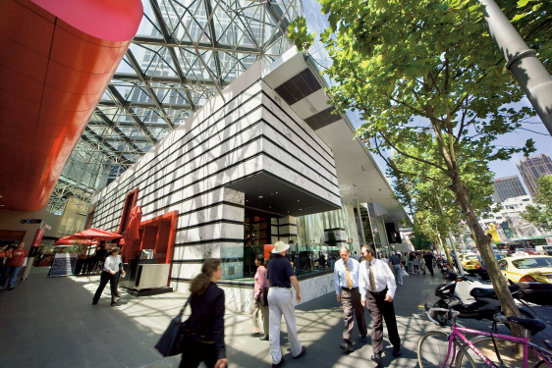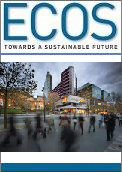
|
Published: 3 October 2011
Green building ratings framework drives more sustainable communities
The Green Building Council of Australia’s (GBCA) Green Star – Communities project will recalibrate and measure the concept of a sustainable community. The project aims to drive the collaborative planning and development of our communities on broad viability principles.

|
|
A view across Melbourne’s Swanston Street to the QV complex which integrates shopping, dining and living experiences. Credit: Courtesy of GBCA
|
In 2009, the GBCA began consulting with industry about how to shift from greening our buildings to greening entire communities. The feedback was definitive: a rating tool to help transform and better plan our communities was the answer.
There was also clear demand for the inclusion of the full spectrum of sustainability; industry needed guidance on how to create communities that met a range of economic and social priorities, as well as environmental priorities.
The Green Star – Communities project is unrivalled in Australia in terms of its ambitious scope and vision. There is currently no independent, third-party rating scheme that assesses and certifies the sustainability of community-level projects in Australia.
Talented people from all areas of industry have come together to work on the project – including stakeholders from academia, social and town planning, project and development management, economics, policy, urban design, scientific and environmental engineering, and all three tiers of government. In total, 75 people sit on a technical working committee, 35 on a technical expert panel and a further 25 on an integration and implementation committee.
The first step was establishing a national framework for sustainable communities. By 2010, the framework had outlined five national best-practice principles to guide sustainable communities in Australia: liveability, economic prosperity, environmental responsibility, design excellence, and visionary leadership and governance.
Once the five principles were clearly articulated, GBCA’s technical ratings team commenced work on the ratings credits in late 2010. The credits underpin each principle in GBCA’s framework systems. Thirty-eight draft pilot credits have now been developed and are being beta-tested by 28 projects around Australia: in Darwin, Perth, Adelaide, Melbourne, Canberra, Sydney, Brisbane, the Sunshine Coast and Townsville. The projects range from small, private sector infill projects to large, government master-planned precincts.
One of the companies testing draft pilot credits is Lend Lease, which has sponsored the Green Star – Communities project. It is now assesssing Victoria Harbour in Melbourne, Sydney’s Barangaroo, the redevelopment of the RNA Showgrounds in Brisbane and the Alkimos project in Western Australia.
Ms Cate Harris, Lend Lease’s Head of Sustainability, says the company’s sponsorship has enabled it to play a central role in the development of this new rating tool. Ms Harris says the tool will ‘expand the thinking on green buildings into the development of green precincts’.
One of the credits Lend Lease and other partners will be testing is the ‘Healthy and Active Living’ credit, contained within the ‘Liveability’ category, which seeks to promote developments that encourage just that: healthy and active lifestyles. The credit rewards developments that embody principles based around a number of planning and design strategies.

|
|
The Green Star – Communities project is designed to recalibrate and measure the concept of a sustainable community, including those in central city areas. Credit: Courtesy of GBCA
|
Within the ‘Leadership and Governance’ category, a credit for stakeholder engagement articulates a best-practice approach to planning, designing and implementing engagement strategies for built environment projects. The credit provides developers with clear guidance on identifying and understanding their relevant stakeholders before engaging with them, to ensure that engagement strategies match stakeholders’ needs.
In the past, nationally consistent best-practice built environment outcomes have been difficult to achieve when policies and regulations have been driven at a state or local government level. However, once complete, the Green Star – Communities rating tool will become a voluntary national standard, as every state and territory government land organisation is supporting the development of the rating tool.
One of the government land organisations supporting the Green Star – Communities tool development process is South Australia’s Land Management Corporation (LMC).
‘LMC saw a unique opportunity for the entire government land organisation network across Australia to support a sustainability precinct tool where none really existed,’ says Mr Phil Donaldson, Director of LMC’s Sustainability Policy and Programs. ‘[This] provides a level of consistency and certainty to the development industry on how we view sustainable development.’
Mr Donaldson says that, once released, the tool will support LMC’s business outcomes as they relate to its own development strategy.
‘We are concerned about the holistic approach of sustainability in delivering economic benefits to our stakeholders and ensuring that environmental, social and community outcomes are integral in that process,’ he says. ‘Being involved in Green Star – Communities has reaffirmed our own directions, provided opportunities for collaboration on leading-edge approaches and built relationships with other government agencies and the industry in delivering our future outcomes.’
The Green Star – Communities rating tool will provide federal government with a vehicle for delivering policy outcomes, state governments with guidance for planning and approval of significant projects, and local governments with a framework for greater sustainable development outcomes. However, the tool is not solely for governments. It will facilitate more efficient development processes, and ultimately help developers get their products out to market quicker. Financiers gain a framework for sustainable investment, and consumers will be able to make informed decisions about the lifestyles they choose.
Once complete in 2012, the Green Star – Communities rating tool will usher in a new era of sustainable development: one that looks beyond just environmental efficiencies in the built environment to providing the far broader and more integrated conditions for living efficiently, productively and healthily in keeping with the local environment.
Adam Beck is Manager, Sustainable Communities at the Green Building Council of Australia.



